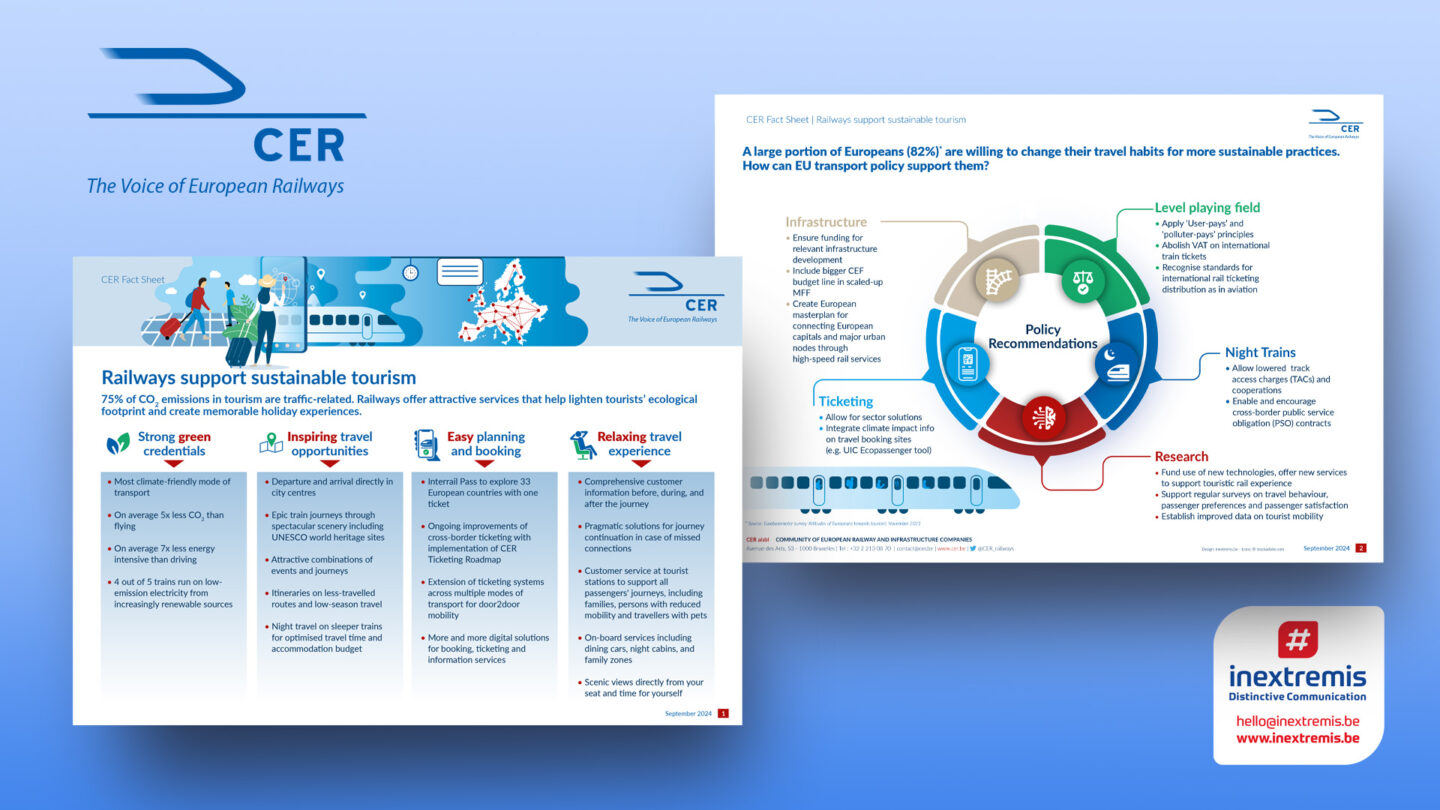Railways: a sustainable path for European tourism

How the European railway sector is paving the way for eco-friendly travel experiences
Tourism is one of the most rewarding experiences for many people. Still, it comes at a cost—75% of CO₂ emissions in the tourism sector come from transport alone. This staggering figure highlights a critical issue: How can we continue to explore the world while minimising our ecological footprint? European railways, as champions of sustainable travel, offer a compelling answer. With their solid green credentials and enhanced passenger experience, trains lead the charge in redefining tourism for a more sustainable future.
Why railways stand out in the quest for sustainable tourism
Trains have long been celebrated as one of the most climate-friendly modes of transport. The latest CER Fact Sheet, “Railways Support Sustainable Tourism,” highlights that trains produce, on average, five times less CO₂ than air travel and seven times less energy than driving. With 80% of European trains running on low-emission electricity—often sourced from renewables—the sector is setting an example of how to decouple growth in tourism from environmental harm.
Beyond being eco-friendly, railways offer unique travel opportunities that are hard to match with other modes of transport. From scenic journeys through UNESCO World Heritage sites to convenient city-centre arrivals and departures, trains invite passengers to travel responsibly and enjoy every mile of their journey. Night trains further complement this, allowing passengers to optimise their travel time while reducing accommodation costs—making railways greener and more innovative.
The allure of travelling by train: more than just a ride
Travelling by train is more than a simple mode of transportation; it’s an experience. The European Interrail Pass allows tourists to explore up to 33 countries with a single ticket, opening doors to endless adventures. The appeal of train travel is further enhanced by the continuous improvement of cross-border ticketing and the integration of multimodal solutions. Thanks to ongoing digital innovations, booking, ticketing, and customer service have become more streamlined, offering a seamless journey from start to finish.
Even more impressive is how railways cater to solo travellers, families, people with reduced mobility, and even pet owners. From dining cars to family zones and sleeper cabins, trains provide tailored services for all passengers. The ability to gaze out at breathtaking landscapes while enjoying onboard amenities transforms the train journey into a relaxing, memorable experience that is as enriching as the destination.
Policy support: the missing link for maximising railway potential
Despite their advantages, railways face significant competition from other modes of transport, particularly in terms of pricing and convenience. The CER has outlined vital policy recommendations that could level the playing field. Abolishing VAT on international train tickets, applying the “user-pays” and “polluter-pays” principles, and recognising international rail ticketing standards are just a few of the measures proposed.
Additionally, there is a call for increased infrastructure investment. A European masterplan connecting capitals and significant urban nodes through high-speed rail services would make rail travel a viable alternative for even more people. The CER also advocates for enhanced cross-border public service obligations, allowing for greater cooperation and more attractive rail services between countries.
A roadmap for the future: why supporting rail tourism matters
The future of tourism must be connected to the need for sustainable solutions, and railways are uniquely positioned to lead the way. With the proper policy framework and continued investment, railways can attract a more significant share of tourist travel, reducing emissions and supporting the EU’s climate goals.
Moreover, as the CER report suggests, passengers are increasingly willing to adopt more sustainable travel habits. According to a Eurobarometer survey, 82% of Europeans said they would consider changing their travel behaviour for more eco-friendly options. With its expanding services and enhanced infrastructure, the railway sector is ready to meet this demand.
Final thoughts
At #inextremis, the role of creative agencies extends beyond traditional communications. By working closely with organisations like CER, we help amplify messages that matter—messages that drive change and support a sustainable future. Promoting railway travel as a cornerstone of sustainable tourism is not just about advertising train journeys; it’s about redefining what it means to travel responsibly in today’s world.
Let’s keep pushing the boundaries and create communication support that resonates, inspires, and drives the shift towards greener tourism.
——
This article is inspired by the CER Fact Sheet “Railways Support Sustainable Tourism.” If you want to partner with a creative agency that understands the nuances of communicating complex topics, we are here to help. Contact us today to see how we can support your communication needs.
To learn more, visit the CER website: https://www.cer.be